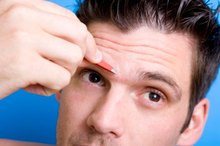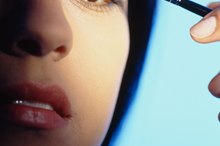Small Red Bumps Under the Eyes
Several skin conditions may cause the appearance of small red bumps under the eyes. Most of them are not serious, but if your under-eye bumps are accompanied by other symptoms such as itchiness, pain or swelling, or if they get bigger with time, it is best to see a health professional for a diagnosis and treatment.
Conditions
Conditions that may cause small red bumps under the eyes include: acne, dermatitis, keratosis pilaris, styes and rosacea 23. If you have oily skin, the bumps may be pimples caused by acne, but if your skin is dry and the bumps look like very small pimples, you may have a skin condition called keratosis pilaris 3. Itchy under-eye bumps may indicate you have contact dermatitis caused by an allergic reaction to a cosmetic or allergen 2. If you have a bump on the edge of your eyelid or on the eyelid itself, you may have a stye or an inflammatory eye condition called occular rosacea. A doctor should be able to determine which type of skin condition is causing the bumps by talking to you about your symptoms and examining your skin.
OTC and Home Remedies
How to Remove Milia Under Eyes
Learn More
Treatments for red bumps under the eyes vary depending on the cause of the bumps. Depending on their severity, most of the conditions that cause red bumps under the eyes, with the exception of occular rosacea, can be treated with home-care measures such as applying warm compresses or using over-the-counter topical treatments. For acne and keratosis pilaris, both topical exfoliants such as salicylic acid and topical retinoids may help; whereas, if the bumps are itchy and rash-like as in dermatitis, taking antihistamines or applying creams containing hydrocortisone may relieve your symptoms 23.
Prescriptions and Procedures
Depending on both the type of skin condition responsible for the red bumps and the severity of your condition, your doctor may prescribe medication or perform a procedure as part of your treatment. To treat an infection or rash on the skin, your doctor may prescribe a prescription face cream such as prescription-strength retinoic acid or steroidal creams, or an oral medication such as antibiotics or oral steroids. It is unlikely that you will require a medical procedure to treat your skin bumps unless you have a large stye or boil that does not drain after home treatment with warm compresses, in which case the doctor may surgically drain it.
Prevention
Folic Acid & Acne Rosacea
Learn More
In many cases, you can prevent skin conditions the cause the appearance of small red bumps under the eyes by taking certain precautions with your facial hygiene. Always removing all your makeup at the end of the day, keeping your face free of oily cosmetics, and not touching your skin or eye with unclean hands can help prevent both styes and acne. Avoiding skin irritants such as perfumed cosmetics and other allergens can prevent contact dermatitis 2. There is no known reliable way to prevent keratosis pilaris or occular rosacea, although keratosis pilaris worsens with dry skin 3.
When to See a Doctor
Although small bumps that do not hurt or itch are likely nothing to worry about, you should see a doctor if the bumps hurt, itch or appear to be infected, or don't improve with time or self-care remedies. In these cases, your condition may not improve unless you are treated with antibiotics or other medications. It is also particularly important to see a doctor if you have signs of occular rosacea, including dry, red eyes and vision problems, as this condition may worsen if left untreated.
Related Articles
References
- Mayo Clinic: Acne
- Mayo Clinic: Dermatitis
- Mayo Clinic: Keratosis Pilaris
- Skinsight.com: Stye Stye (Hordeolum and Chalazion) in Adults
- Mayo Clinic: Ocular Rosacea
- Wang JF, Orlow SJ. Keratosis pilaris and its subtypes: Associations, new molecular and pharmacologic etiologies, and therapeutic options. Am J Clin Dermatol. 2018;19(5):733-57. doi:10.1007/s40257-018-0368-3
- Thomas M, Khopkar US. Keratosis pilaris revisited: Is it more than just a follicular keratosis?. Int J Trichology. 2012;4(4):255-8. doi:10.4103/0974-7753.111215
- Wang JF, Orlow SJ. Keratosis pilaris and its subtypes: Associations, new molecular and pharmacologic etiologies, and therapeutic options. Am J Clin Dermatol. 2018;19(5):733-57. doi:10.1007/s40257-018-0368-3
- Gruber R, Sugarman JL, Crumrine D, et al. Sebaceous gland, hair shaft, and epidermal barrier abnormalities in keratosis pilaris with and without filaggrin deficiency. Am J Pathol. 2015;185(4):1012-21. doi:10.1016/j.ajpath.2014.12.012
- Liu F, Yang Y, Zheng Y, Liang YH, Zeng K. Mutation and expression of ABCA12 in keratosis pilaris and nevus comedonicus. Mol Med Rep. 2018;18(3):3153-8. doi:10.3892/mmr.2018.9342
- Pennycook K, McCready T. Keratosis pilaris. In: StatPearls. Updated September 13, 2019.
- Sonthalia S, Bhatia J, Thomas M. Dermoscopy of keratosis pilaris. Indian Dermatol Online J. 2019;10(5):613-4. doi:10.4103/idoj.IDOJ_279_18
- Peter Rout D, Nair A, Gupta A, Kumar P. Epidermolytic hyperkeratosis: clinical update. Clin Cosmet Investig Dermatol. 2019;12:333-44. doi:10.2147/CCID.S166849
- Kootiratrakarn T, Kampirapap K, Chunhasewee C. Epidermal permeability barrier in the treatment of keratosis pilaris. Dermatol Res Pract. 2015;2015:205012. doi:10.1155/2015/205012
- Schwitulla J, Brasch J, Löffler H, Schnuch A, Geier J, Uter W. Skin irritability to sodium lauryl sulfate is associated with increased positive patch test reactions. Br J Dermatol. 2014;171(1):115-23. doi:10.1111/bjd.12893
- Ciliberto H, Farshidi A, Berk D, Bayliss S. Photopneumatic therapy for the treatment of keratosis pilaris. J Drug Dermatol. 2013 Jul;12(7):804-6.
Resources
Writer Bio
Shannon George, former editor-in-chief of the trade magazine "Prime," holds a Bachelor of Arts in English from San Diego State University. Her health interests include vegetarian nutrition, weight training, yoga and training for foot races.









